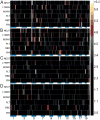Genetic background influences susceptibility to chemotherapy-induced hematotoxicity
- PMID: 28607509
- PMCID: PMC5729066
- DOI: 10.1038/tpj.2017.23
Genetic background influences susceptibility to chemotherapy-induced hematotoxicity
Abstract
Hematotoxicity is a life-threatening side effect of many chemotherapy regimens. Although clinical factors influence patient responses, genetic factors may also play an important role. We sought to identify genomic loci that influence chemotherapy-induced hematotoxicity by dosing Diversity Outbred mice with one of three chemotherapy drugs; doxorubicin, cyclophosphamide or docetaxel. We observed that each drug had a distinct effect on both the changes in blood cell subpopulations and the underlying genetic architecture of hematotoxicity. For doxorubicin, we mapped the change in cell counts before and after dosing and found that alleles of ATP-binding cassette B1B (Abcb1b) on chromosome 5 influence all cell populations. For cyclophosphamide and docetaxel, we found that each cell population was influenced by distinct loci, none of which overlapped between drugs. These results suggest that susceptibility to chemotherapy-induced hematotoxicity is influenced by different genes for different chemotherapy drugs.
Conflict of interest statement
DMG and GAC are employed by The Jackson Laboratory, which sells Diversity Outbred mice.
Figures







References
-
- Callens C, Debled M, Delord M, Turbiez-Stalain I, Veyret C, Bieche I, et al. High-throughput pharmacogenetics identifies SLCO1A2 polymorphisms as candidates to elucidate the risk of febrile neutropenia in the breast cancer RAPP-01 trial. Breast Cancer Res Treat. 2015;153(2):383–389. - PubMed
-
- van der Slot AJ, Zuurmond AM, Bardoel AF, Wijmenga C, Pruijs HE, Sillence DO, et al. Identification of PLOD2 as telopeptide lysyl hydroxylase, an important enzyme in fibrosis. The Journal of biological chemistry. 2003;278(42):40967–40972. - PubMed
Publication types
MeSH terms
Substances
Grants and funding
LinkOut - more resources
Full Text Sources
Other Literature Sources
Medical
Molecular Biology Databases

